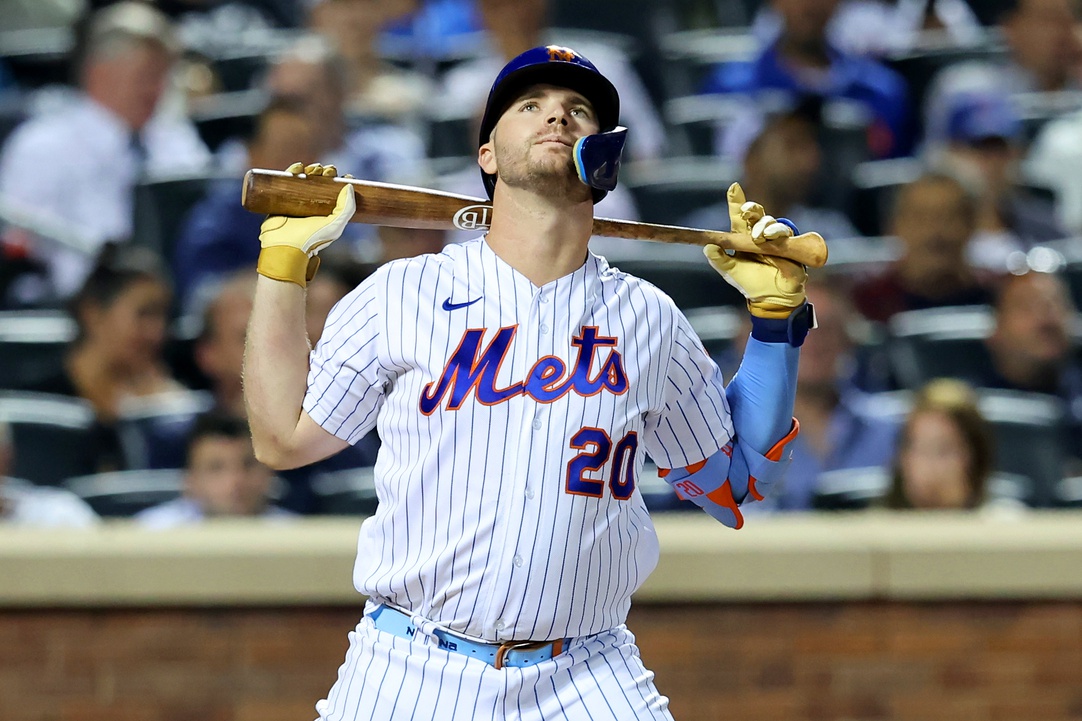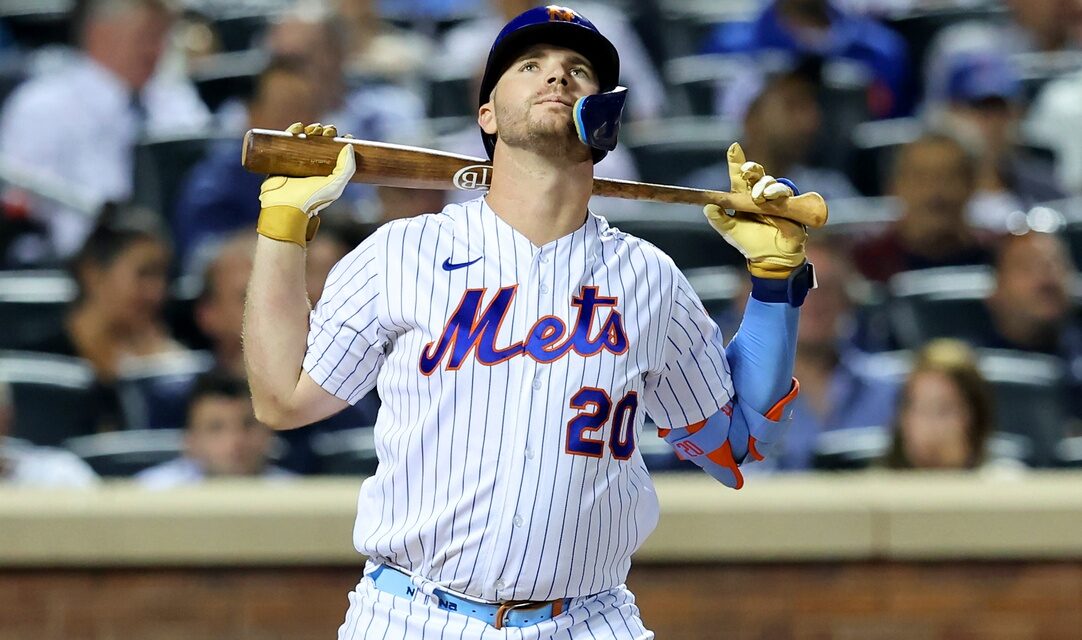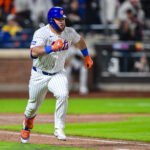
Brad Penner-USA TODAY Sports
Yesterday, we started to analyze the Mets’ struggles—and successes—on offense over the last couple of years. Read Part 1 here.
Today, we continue the dive into the team’s overall struggles with Part 2.
Struggles Vs. Specific Pitches
The Mets are struggling against a number of different pitch types compared to 2022. Some are also below average, but some are just worse than last season. For this measure, we’re going to go with Run Value per 100 pitches (wRV) from Statcast (listed on FanGraphs), which is not necessarily predictive for future performance but gives some context to what happened in the past.
In 2022, the Mets ranked fourth-best in wRV on four-seam fastballs at 0.52; this season, they’re ranked 13th at 0.28. That’s almost down to half the run value. Although 13th isn’t bad, considering fastballs are the most-thrown pitch across baseball (32.4% of the time in 2023, per Statcast) and the Mets have faced 32.9% fastballs, which ranks 11th-highest, that’s a large loss of run value.
The Mets have faced sliders 19.3% of the time this season, ranked 28th across baseball, but the team’s second-most frequent pitch type faced. Their wRV against the pitch is actually fifth across baseball at 0.29, which is likely why they see fewer sliders than most other teams. They were 11th in baseball in wRV against the slider last season, but it was -0.13. That’s a large improvement but on a far less frequently-used pitch.
It’s the sinker that gets the Mets in particular trouble. They’ve faced the second-highest rate of sinkers in baseball at 18%, and their wRV against the pitch is -0.60, which ranks 19th in baseball. Pitchers have identified the Mets’ weak spots. This is new compared to 2022 when they ranked 14th with a -0.14 wRV.
The Mets also struggle mightily against the changeup (-0.67 wRV, 28th) and cutter (-0.65 wRV, 24th), and they see the pitches 10.5% and 7.5% of the time, respectively. In 2022, they ranked second with 1.04 wRV against the changeup and fourth with 0.73 wRV against the cutter.
Overall, there are four different pitches that the Mets’ weighted run value has significantly decreased against compared to 2022. The only pitch that they are doing better against is the slider, but it’s at the expense of the fastball, sinker, cutter, and changeup.
Take this with somewhat of a grain of salt because of its lack of predictiveness. Still, it shows that this is a wide-ranging problem, not just limited to one particular pitch type.
Expected vs. Actual Statistics
The Mets’ team xBA is ninth in baseball at .253, but they’re 20th in actual batting average at .241. They’re 13th in xSLG at .419, but 20th in actual SLG at .394. That has led to a .713 team OPS, ranked 22nd in baseball.
In 2022, the Mets ranked second in all of baseball with a .252 xBA and eighth with a .404 xSLG. (You can see that batting stats are significantly higher in 2023 than the year prior, particularly where power metrics are concerned.) Their actual batting average was second at .259, and their SLG was eighth at .412. That gave them a .744 team OPS, the sixth-best in baseball.
Why are the Mets underperforming their expected metrics this season when they performed right about at those metrics a season ago?
Furthermore, this was not the case in 2021. The Mets’ xBA in 2021 was .238, and their actual BA was .239. Their xSLG was .393 and their SLG was .391. Their OPS was 23rd that season at .706. 2023 seems to be a different animal altogether from that perspective.
Some would view the difference in expected metrics and actual numbers as predictive of a regression to the mean and better results. Especially in light of the Mets’ lower BABIP numbers, this would seem to be the case. However, as explained here, utilizing expected stats to predict future outcomes is nebulous. The expected stats explain what was most likely to happen in the past, not what will actually happen in the future.
The one thing to note, though, is that high exit velocities and launch angles tend to perform according to their xBA. Groundballs, no matter how hard they’re hit, are more likely to be snagged by the defense. With decreased line drive rates, perhaps the Mets are encountering the bad luck of BABIP which is the bedrock of the power strategy across baseball.
Specific Players Struggling
The Mets’ offense lived and died by Lindor and Alonso last season: sometimes one, sometimes the other, and, and the team’s best, both.
The best example of this was last June. Lindor fractured his finger and hit .205/.255/.362 that month. Although Alonso hit well at .265/.351/.627, the Mets as a team hit .232/.301/.369 and scored just 4.0 runs per game, their lowest average of any month last season. They went 13-12, also their worst win percentage of all the months (if you join the five games in October with September’s numbers, as Baseball Reference does).
The Mets’ best month by record was in April when Lindor hit .282/.367/.482. Their second-best was July when Lindor hit .320/.393/.540, and their third-best was May when Alonso hit .315/.398/.611. They scored 5.79 runs per game in May, by far their best month by scoring output.
So far this season, Alonso had a stronger April, hitting .257/.328/.562. Of the two months, Lindor also hit better in April at .218/.316/.446. Predictably, the Mets scored 4.52 runs per game and had a .556 win percentage.
In other words, when one of the two is struggling mightily, so do the Mets usually go. If one or the other is scorching hot, that’s often enough to carry them to victory. If both are hitting solidly but not great, it will be up to the rest of the Mets’ lineup to determine their success.
Lindor had a poor month in May, hitting .227/.273/.412. Alonso hit .219/.339/.543, a decent OPS but a poor batting average, which made him very boom-or-bust. The Mets went 14-15 in May and scored 4.38 runs per game, which would have been the third-lowest-scoring month for the Mets in 2022 (they were worse in June at 4.00 and July at 4.36). The difference was that in 2022, the Mets’ starting pitching bailed them out through the dog days of early summer when Jacob deGrom and Max Scherzer were both injured; this year, that has often not been the case.
Furthermore, the Mets’ run-scoring has been spread out very widely. They have scored two runs or fewer in 22 of their 60 games (37%), but they have also scored seven or more runs 13 times (22%). Their most common run-scored number is five (11 times), and they are 9-2 in those games, but they’ve also scored two runs nine different times and have been shut out eight times.
Overall, this kind of inconsistency points largely to being reliant on two hitters for the offense. Yes, there have been other players struggling this season, but as Alonso and Lindor go, the Mets’ offense tends to go, as well.
Are There Answers?
The issues are so manifold that it is difficult to give one particular answer. Pulling more might be a good first step as a team. Getting more aggressive within the strike zone should be a point of emphasis. But when so many good hitters are struggling so badly and cannot find their way out of it, it’s sometimes possible to chalk it up to coaching. Jeremy Barnes, the hitting coach, would be the first culprit, but Eric Chávez, last year’s hitting coach and this season’s bench coach, didn’t just suddenly disappear.
However, maybe this speaks to something far more fundamental. There is a reason that MLB teams focus far more on power than contact: because it wins games. Last season, the Mets were able to win despite low hard-hit and barrel rates with high weak contact and groundball rates. Perhaps that was an anomaly more than instructive.
Even though stolen bases are more prevalent this season than before and batting averages are up, small ball as an approach to the game is still a way of the past. Even without the shift, a single hit through the hole does not have as much value as driving the ball.
Having low strikeout and high walk rates are only two parts of the equation. Without the power, these problems are likely going to continue to plague the Mets. Francisco Álvarez had his power streak, and perhaps he will be able to be another thumper in the Mets’ lineup going forward (despite currently being mired in a bad slump). But without consistent extra base and home run power, everything needs to go right for an offense to succeed. Continuing to insist on the same offensive approach is not going to do the team favors.
Other than that, though, this may just be a team-building flaw that needs to be addressed in the offseason. That’s a sinking prospect for June if it is indeed the case.
















